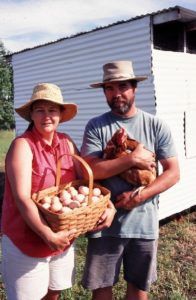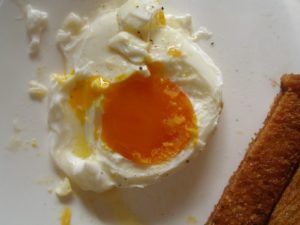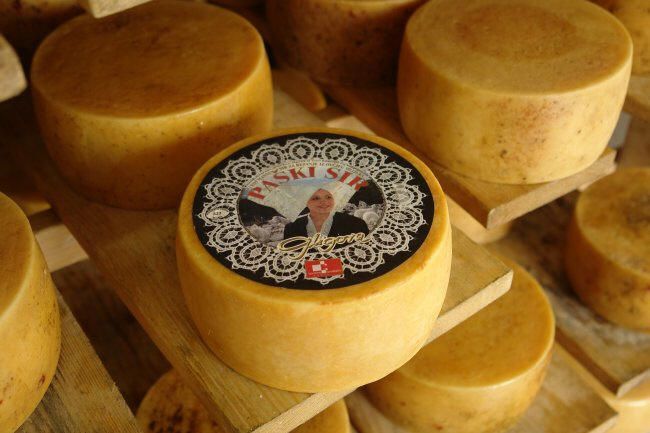The Humble Egg

Having fallen from grace in the 1980s, the humble egg is being resurrected and restored to an honorable place in the kitchen.
Once upon a time, the humble egg was the symbol of life, containing within its shell all that was needed to sustain a newly hatched chicken. For millennia, civilizations cracked, stirred, beat, whipped, and poached, enjoying the resultant egg delicacy guilt-free.
Then something happened. Sometime in the 1970s or ’80s, eggs fell from grace. They were no longer a symbol of life but of potential death. They were accused–wrongly, as it turns out–of raising serum cholesterol, which was considered a factor in coronary disease. For two decades, eggs were disparaged–yolks were eliminated from recipes, egg substitutes were created out of plums and other un-egglike and almost unpalatable commodities. With cholesterol concerns compounded by potential Salmonella contamination, the egg hit bottom.
But recently science has changed direction. Just as it did an 180-degree about-face over nuclear winter, trading in that environmental theory for global warming, it has now determined that eggs are back in. Many scientists no longer believe that there is a direct link between cholesterol in the diet and serum cholesterol levels. That is good news for egg lovers around the world–and didn’t you intuitively know it all along?
Not all eggs are created equal
I personally long to have my own flock of heirloom chickens, but that requires a lot more space than I now have. So I depend on others to supply my eggs. I visit the farmer’s market and regional purveyors to forage for the best quality.I believe all eggs have the genetic potential to be equal, but I’ve found that how the chickens are fed greatly impacts the finished egg–that is, nature vs. nurture.
 Do the experiment yourself. Buy a dozen eggs from a small organic-egg and -chicken producer in your area and another dozen eggs from the local supermarket. Crack a couple eggs from each carton together into a bowl. I guarantee you will see a marked difference between the yolks. The store-bought will be a much paler yellow and usually smaller, while the farmer’s eggs will be dark yellow, even orange (see picture at right) and larger. I have even seen farm-raised eggs with bright orange yolks.
Do the experiment yourself. Buy a dozen eggs from a small organic-egg and -chicken producer in your area and another dozen eggs from the local supermarket. Crack a couple eggs from each carton together into a bowl. I guarantee you will see a marked difference between the yolks. The store-bought will be a much paler yellow and usually smaller, while the farmer’s eggs will be dark yellow, even orange (see picture at right) and larger. I have even seen farm-raised eggs with bright orange yolks.
This difference comes from the diet. While many egg cartons now claim their chickens are “free-ranged,” unfortunately it isn’t dependable labeling anymore, because some confinement egg producers leave a small door for the chickens to exit the confinement sheds, even if they never do. Some let them roam around inside big barns, but they never see a blade of grass. The new standard for eggs is “pasture-fed” eggs. The term pasture-fed usually means that in addition to some supplemental grains, the chickens are allowed to forage on pasture where they can incorporate wild plants and omega-3-rich bugs into their diet. Joel Salatin is the pioneer of a moving-cage system that keeps the chickens safe from predators, but gives them access to fresh pasture every day.
While you might not find these best-quality eggs at the local supermarket anytime soon, organic food stores usually carry several different kinds, and more and more restaurants are pioneering farm-to-restaurant connections with small egg producers. Patronize these restaurants and treat yourself to traditional and nutritious egg dishes and desserts like the unbelievably yellow créme brûlée I recently enjoyed at Bistro Lepic in Washington, D.C. Chef Bruno Fortin created this timeless French classic with the bright-orange egg yolks from free-roaming chickens raised on Amish and Mennonite farms in Pennsylvania.
Whether you have easy access to true free-range or pasture-fed chickens’ eggs may be a factor in whether you can use them extensively, but do guiltlessly reincorporate the simple egg back into your diet–no matter the source. And when you can prepare or purchase egg dishes made with the best-quality eggs, you’ll not only be getting superior nutrition, but you’ll also be helping to preserve some small family farms at the same time.
Scrambled Eggs with Ricotta Cheese
This recipe from Marie Simmons’ new cookbook The Good Egg is the perfect way to make eggs for a Sunday brunch. I buy ricotta freshly made from Guernsey cows at a local farmer’s market. Used by permission of the author.
- 6 large eggs
- 1 cup whole-milk ricotta
- 1 Tbsp. unsalted butter
- Sea salt and fresh-ground black pepper
- 1 Tbsp. torn fresh basil leaves
Combine the eggs and ricotta in a large bowl and whisk until blended. Melt the butter in a large, nonstick skillet over medium-low heat. When the foam subsides, add the egg mixture. Cook, stirring constantly, until the eggs are soft-set but still creamy, about 3 minutes. Do not allow the eggs to develop a curdlike consistency–that means they are overcooked. Sprinkle with salt to taste and a grinding of pepper. Sprinkle with the basil leaves and serve at once.
Pepper n’ Egg Skillet Supper
This is a quick and easy way to make a fun evening meal.
- 1 tsp. lard
- 7 cups thinly sliced sweet red, green, and yellow peppers in rings or strips
- 1½ cups thinly sliced onions
- 2-3 cloves garlic, finely minced
- 2 Tbsp. Balsamic vinegar
- 4 eggs
In a 10-inch nonstick pan or skillet over medium heat, cook the peppers, onions, and garlic in hot oil, without stirring, about 3-4 minutes. Continue cooking, stirring occasionally, until vegetables are tender and all the liquid has evaporated. Stir in the vinegar and cook until evaporated.
With the back of a wooden spoon, make 4 indentations in the vegetable mixture. Break open and slip a whole egg into each indentation. Cover and cook over medium heat until whites are completely set and yolks begin to thicken but are not hard, about 3-4 minutes. Serves 4.

